BY LINCOLN ANDERSON | Rising from their seats in the City Council Chamber’s balcony and angrily chanting “Vote No!” for several solid minutes, opponents disrupted Thursday’s vote on the contentious East Side Coastal Resiliency project. Council security ended the protest by ordering the balcony to be cleared.
As one of the defiant park activists was being ushered out, she sang, to the tune of Simon & Garfunkel’s “Cecilia,” “Car-lee-na, you’re breaking our heart! You’re killing our park and you know it!”
In the end, the full Council, with Public Advocate Jumaane Williams in attendance, unanimously approved the resiliency project, greenlighting the bulldozing of East River Park to start next fall.
The opponents began chanting right after Councilmember Carlina Rivera started to give remarks before casting her vote in favor of the sweeping project. Rivera — whose district contains the entire 1.2-mile-long East River Park — is the lead councilperson on the plan, which spans from Montgomery St. on the Lower East Side up to E. 25th St.
Also speaking in favor of the scheme were Councilmembers Margaret Chin and Keith Powers. Chin represents the Lower East Side near the southern end of East River Park, while Powers represents the waterfront north of E. 14th St., including Stuyvesant Cove Park.
Per the Council’s usual M.O., the other councilmembers, in casting their votes, deferred and followed the lead of Rivera, Chin and Powers, resulting in a unanimous vote for the plan.
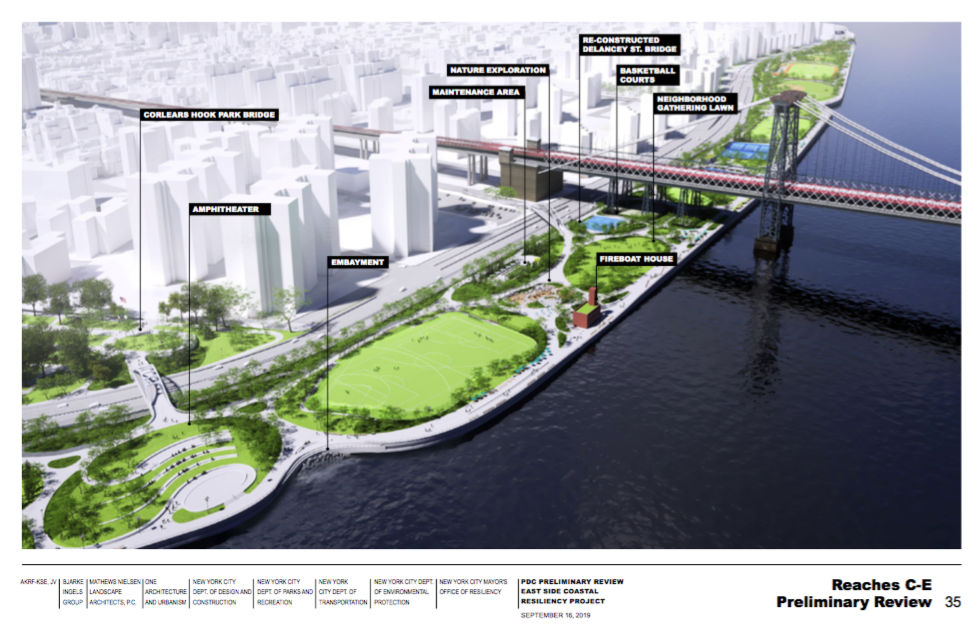
The resiliency initiative, budgeted at $1.45 billion, would raze the entire East River Park, including most of its buildings, structures and foliage, then add soil to raise the park 8 feet. The project’s purpose is to keep the area bordering the park from being flooded as it was in 2012 during Hurricane Sandy.
The resiliency parts of the project are expected to be completed by 2023 — with full park improvements expected to be done by 2025.
Hissing through ‘historic vote’
The opponents hissed throughout the meeting whenever Rivera, Chin or Powers’s names were mentioned, which repeatedly was met by sharp gavel banging and barked orders of “Quiet!”
Among those in the balcony was Brooke Myers, a 20-year resident of the Amalgamated Housing co-ops, at Grand St. and East Broadway. She sported a neon green “O” on her black T-shirt as part of a six-member group sitting together whose shirts spelled out “VOTE NO.” A yoga teacher, she walks her dog in the park every morning.
“I use the lawns for the dog to run. I use everything,” she said. “I sometimes go as far as 23rd St.”
Also in the balcony, Ken Kolosky, who lives in the East River Houses co-ops, said he fears the resiliency plan is, in fact, a real estate plan.
“I think we’re going to see high-rise condos on that land,” he predicted. “I think they’re going to default and that’s what they’re going to do.”
Kolosky said he and his wife purchased their apartment 11 years ago specifically to be near the park, and that he enjoys playing tennis on its courts and using the bike path there.
Johnson: ‘A critical project’
In his remarks, Council Speaker Corey Johnson called the E.S.C.R. plan “a critical project,” and lauded the trio of councilmembers as “tireless advocates for their communities” in hashing out the final scheme.
Rivera, Chin and Powers first spoke earlier in the meeting, as a prelude to the formal vote. They each also spoke later, right before voting.
Rivera said the Council would be casting “a historic vote for climate-change protection.”
“For the last seven years, I’ve watched my community’s slow and painful recovery from Superstorm Sandy,” she said.
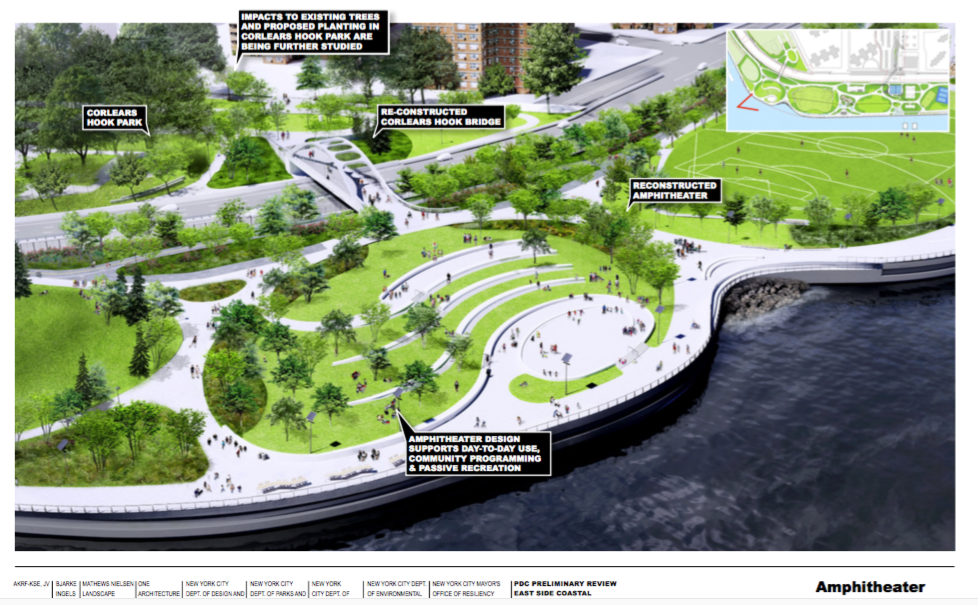
Luckily, there hasn’t been another storm of that magnitude since then, she added — though she warned that one will come sooner or later, and they “will only get worse.”
Rivera: ‘I understand the mistrust’
The resiliency project, Rivera continued, “will address decades of environmental negligence on the Lower East Side,” adding, “I certainly understand the [opponents’] mistrust after decades of neglect.”
Her comment prompted groans and hisses in the balcony. The opponents say the mistrust was created when the city abruptly threw out an earlier version of the plan that had won community consensus, and then instead unilaterally imposed the park-raising scheme.
Rivera touted the revised project’s improvements, including phased construction — meaning at least half the park will be kept open during the work — plus upgrades to other nearby parks that will pick up the slack when East River Park is closed.
“This is a really important personal project for me today,” she declared, as outraged hisses filled the balcony.
Chin: ‘A win for resiliency’
In her remarks, Chin said, “Seven years later [after Sandy], we’re still barely back. Our East Side community can’t wait another seven years.”
The Lower Manhattan councilmember said the E.S.C.R. plan offers “open space improvement, park improvement and [flood] mitigation.”
“This vote is a long time coming,” Chin said. “This is a win for resiliency, climate action and for giving our waterfront communities what they deserve.”
Powers: ‘A well thought-out plan’
Powers called the shoreline scheme “a critical step in New York City’s fight against climate change.” To reject the project, he said, would create “a precedent of throwing away a well-thought-out plan,” plus snubbing federal funding, which is set to expire if it’s not used by 2022.
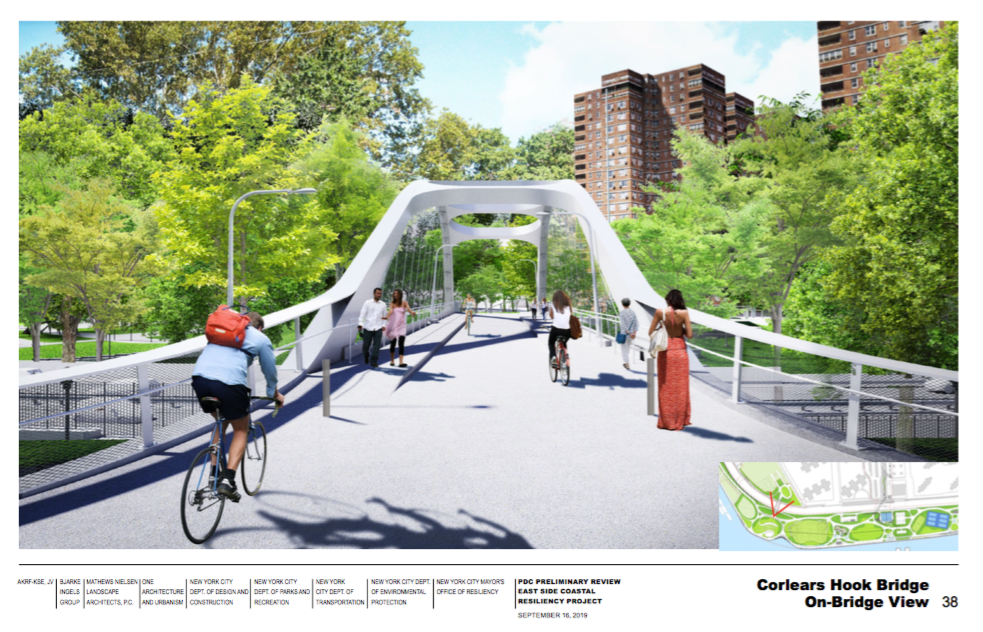
In their remarks before voting, several Brooklyn city councilmembers — including Carlos Mechaca, who represents Red Hook — said they wished they had a similar resiliency project in their districts. Menchaca called E.S.C.R. “a model.”
Coughing eruption
As Powers then spoke again, this time before voting, one man started coughing loudly and suddenly the entire balcony followed suit, erupting in a fit of noisy hacking, until security officers warned them to be quiet.
In the alphabetical roll-call vote, after Powers, the “R”’s of the Council voted next. The protesters had been waiting for this moment for Rivera to start speaking, and launched into their raucous “Vote No!” chant.
After the antis had been booted from the balcony, Rivera, too, spoke to the idea of the resiliency project as a template for other at-risk city flood zones.
“This is the first project of many,” she predicted. “I do hope we can learn from this.”
After thanking a long list of other local politicians and community groups for their support, she proclaimed, “I proudly vote aye on these historic land-use items.”
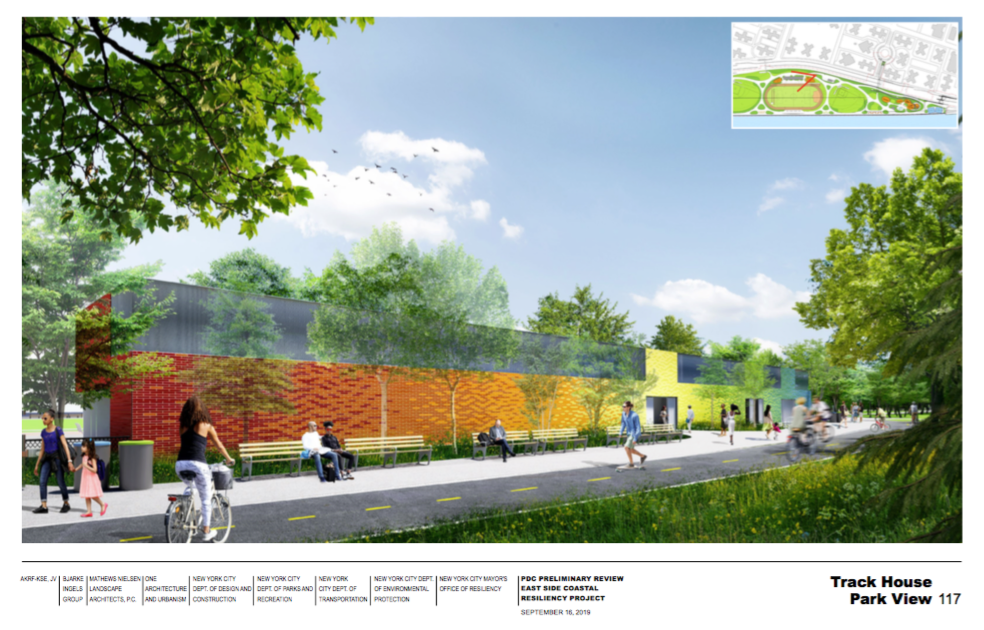
De Blasio: ‘A more resilient city’
After the Council vote, Mayor Bill de Blasio immediately issued a statement of support.
“Hurricane Sandy dramatically changed the lives of New Yorkers all across this city,” he said in the e-mailed statement. “With the rising prevalence of coastal storms in the era of climate change, the passage of the East Side Coastal Resiliency project takes a critical step forward in protecting 110,000 New Yorkers from dangers this city knows all too well. I thank Councilmembers Chin, Powers and Rivera for their leadership as we make New York City a more resilient city for all.”
Clearcutting the park
Standing with allies outside the Council Chamber following the vote, Wendy Brawer, founder of Green Map System, said she was saddened that almost all of the park’s current trees — nearly 1,000 — would be felled. Brawer is a member of the newly formed Tree Task Force that will be giving input on the project.
“Nine hundred seventy-three trees will be cut,” she said. “Eighteen can be saved. A mature tree can be 70 times more absorbent — of C02, other pollutants and rainwater — than saplings.”
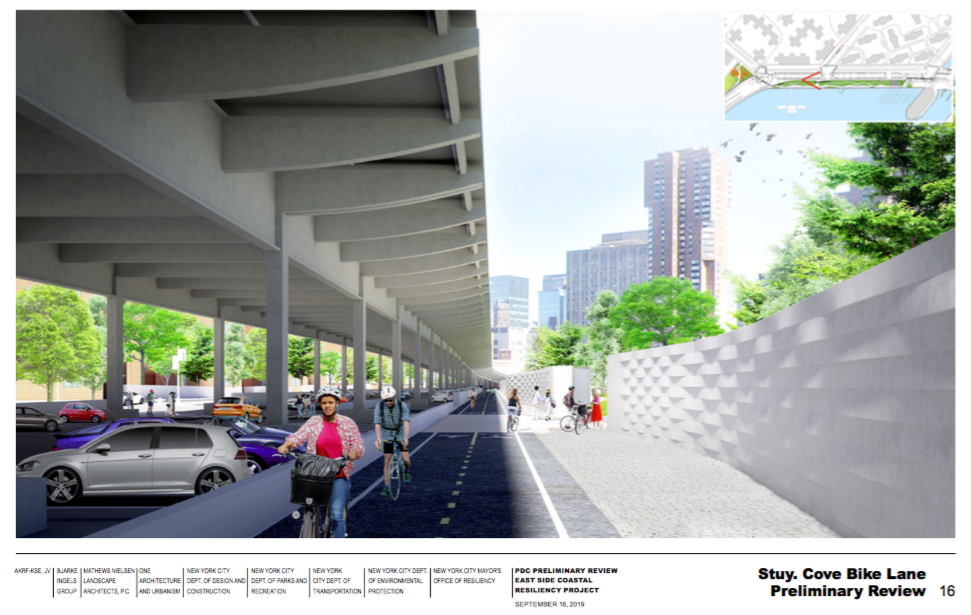
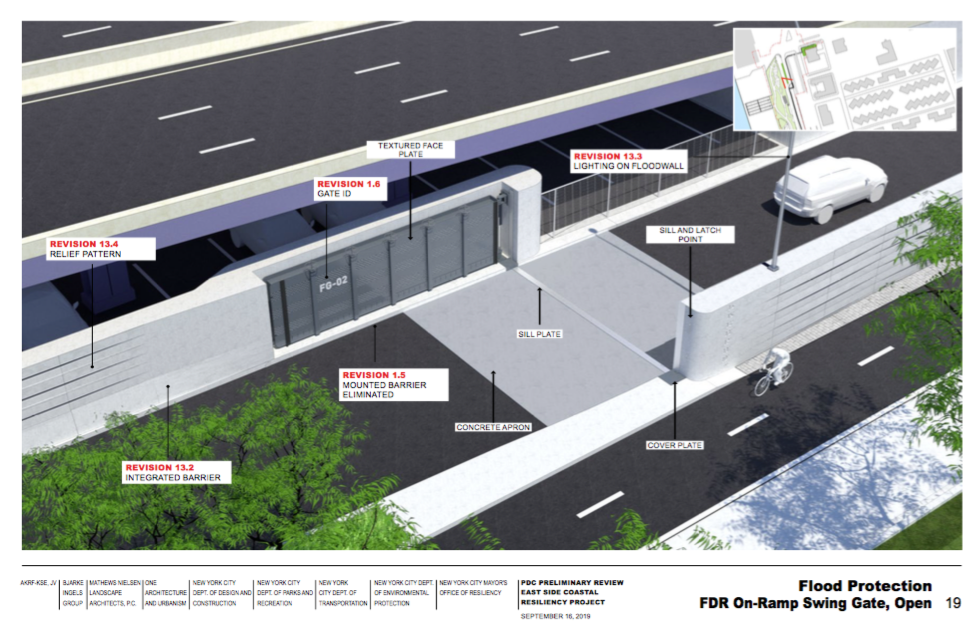
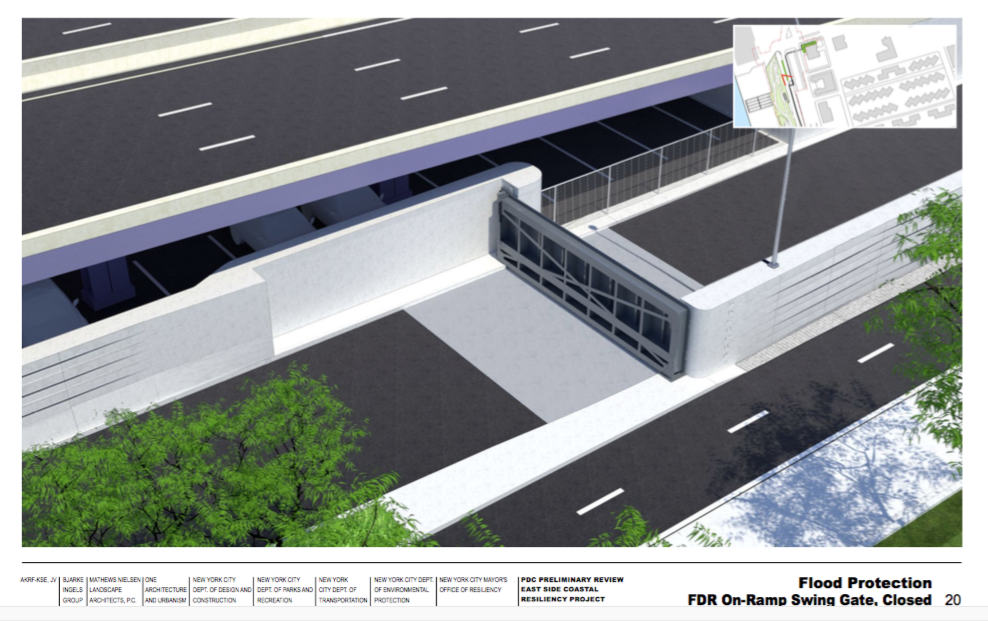
Like the plan’s other opponents, Brawer supports the idea of “decking over” the F.D.R. Drive to create new spaces for sports fields, if not at least for jogging and walking.
The three councilmembers recently reached an agreement with the city on a host of modifications and concessions in connection with the plan.
Construction mitigations
For example, the city has committed to air monitoring, soil testing and noise reduction measures as part of a “robust, transparent environmental monitoring plan” during the E.S.C.R. project’s construction. The results of this monitoring will be reported to a Community Advisory Group that the city committed funds to earlier this month.
In addition, overnight construction will be minimized, the strongest noise mitigation efforts will be employed, and the quietest equipment will be utilized. Nearby residents will receive notice at least two weeks prior to overnight construction beginning. A public phone number will be available for residents to call overnight to report any issues.
Also, the Department of Design and Construction aims to have 30 percent of workers for E.S.C.R. be low- or very-low income persons, including New York City Housing Authority residents.
D.D.C. will minimize the use of truck travel through East Side neighborhoods during construction.
Neighborhood and park improvements
The city is also beginning a campaign to plant 1,000 new street trees in Community Boards 3 and 6, in addition to more than 1,800 new trees planned for the new East River Park itself.
The Department of Transportation, in consultation with local councilmembers and other local stakeholders, is studying the feasibility of installing protected bike lanes on Avenues A, B or C in order to provide an alternative route to the East River Greenway. Study results are expected to be presented to the community next year.
The Environmental Development Corporation will make structural repairs to the deck at Pier 42, at the southern end of East River Park, and install sport fields on it for additional recreation space.
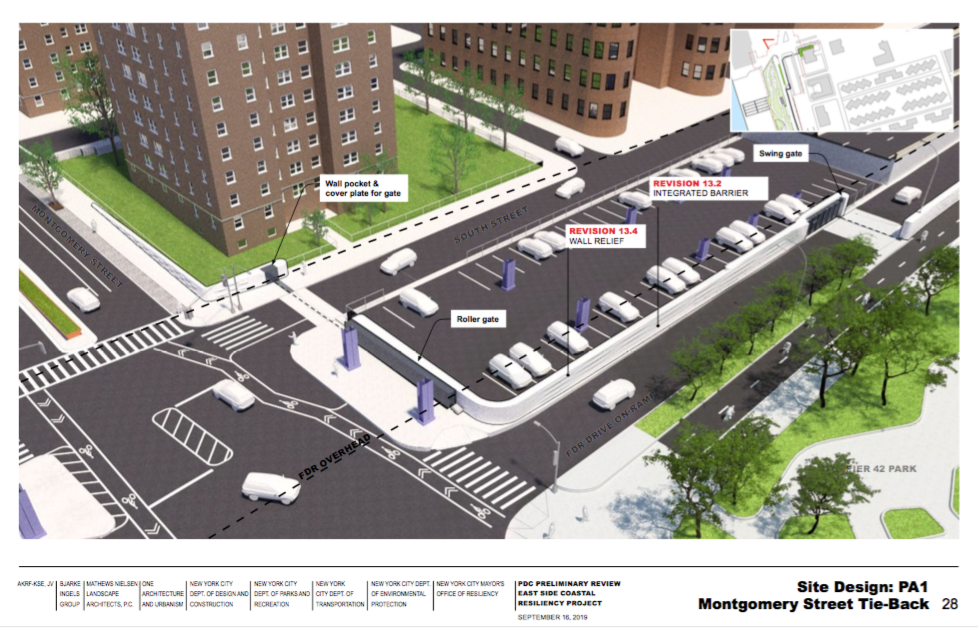
The Parks Department will implement spruce-ups and/or turfing at more than 17 area parks, as well as Waterside Pier, located between E. 38th and E. 41st Sts.
The Department of Education will provide extended hours at more than 10 school recreation sites.
The Parks Department will install mobile solar lights at six local parks.
Open space improvements will be made to at least six NYCHA developments.
Two new barbeque areas will be installed in the Lower East Side and an existing one is being repaired.
The Parks Department has developed a plan for local youth sports leagues that will allow them either to continue operating in East River Park or have priority at alternative recreation sites in the surrounding area.
Parks also will provide various improvements and expanded support for select community gardens that opt in to extended open hours during E.S.C.R. construction.
Additionally, the Parks Department will create a new recreational space at the LaGuardia Bathhouse and put out a request for proposals (R.F.P.) from developers for the Baruch Bathhouse.
D.D.C. will construct a new water play feature near Houston St.
The Lower East Side Ecology Center’s home in East River Park, the Fireboat House, will be preserved, with wet-proofing and additional structural improvements, so that operations can continue there after the E.S.C.R. work is finished. The city will provide an alternate composting area and activity space for the ecology center during construction.
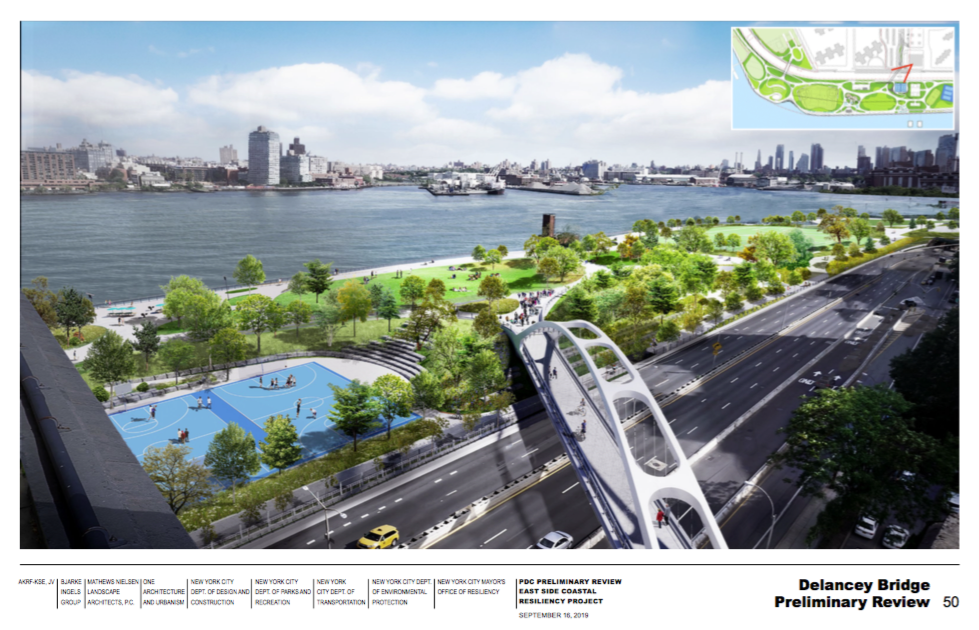
To address the longstanding “pinch point” at 13th St., which disrupts the East River Greenway, D.O.T. will construct a new bridge to provide improved access for both pedestrians and cyclists. Construction will commence after D.D.C. installs the necessary footings and flood-protection system by 2023, with bridge completion targeted for 2025.
Also, D.D.C. will build a new overhead arch structure for the reconstructed East River Park Amphitheater during E.S.C.R. construction. Consultation with the community will continue as part of the Amphitheater Working Group.
D.O.T. will reconstruct all East River Park’s bridges except for the E. Sixth St. bridge.
The city will provide $3 million to address a funding gap for the construction of Solar One’s new facility in Stuyvesant Cove Park.
Monitoring the work
Parks and D.D.C. will create Web resources to direct community members to interim recreation opportunities provided during construction, as well as project updates and construction progress.
D.D.C. will deploy a continual, in-person presence for the entirety of construction, with dedicated, on-the-ground liaisons that will share notices and respond to concerns.
Project’s supporters
In addition to the three councilmembers and the mayor, other E.S.C.R. project supporters include Manhattan Borough President Gale Brewer, Congressmembers Carolyn Maloney and Nydia Velazaquez, state Senator Brad Hoylman, Assemblymember Harvey Epstein, C.B. 3 Chairperson Alysha Lewis-Coleman, C.B. 6 Chairperson Molly Hollister, and District Leaders Daisy Paez, Paul Newell, John Blasco and Aura Olavarria. Other supporters include Susan Steinberg, president of the Stuyvesant Town-Peter Cooper Village Tenants Association; Julie Tighe, president of the New York League of Conservation Voters; Tom Wright, president and C.E.O. of the Regional Plan Association; Tony Rivera, president of LES-OLS Little League; Seth Coren, president of Peter Stuyvesant Little League; Danny Ramirez, executive director and coach for the New York Giants Youth Baseball Club; Ryan Gilliam, executive director of FABnyc; and Camille Napoleon, Tenant Association president at NYCHA’s Baruch Houses.
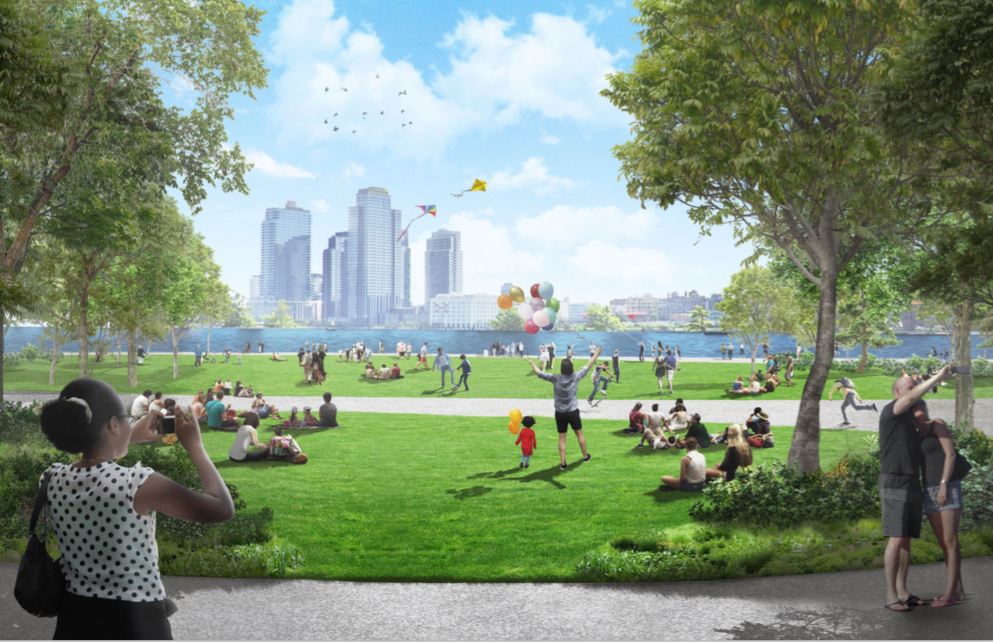
State Senator Brian Kavanagh also endorsed the project, which, he said, due to the three councilmembers’ efforts, will now have “robust oversight.” However, he added, “I continue to be skeptical of the city administration’s overall approach, and the absence to date of any firm assurance that interim flood protections will be in place during construction.”
The project enjoys strong support from local Housing Authority leaders.
“Vladeck Houses, along with our neighboring developments along the waterfront (Campos, LES Infill, Riis, Wald, Baruch, LaGuardia, Two Bridges, Rutgers and Smith Houses) were left helpless with flooded basements, tank rooms, compactor rooms and no heat, hot water or electricity,” Nancy Ortiz, Vladeck’s Tenant Association president, recalled of Sandy. “We were helpless waiting for assistance that never came. We cannot afford to wait any longer for protection because we don’t know when the next storm will hit. I am happy that this plan is going to protect the most vulnerable and ensure that our voices are heard.”
Similarly, Patricia Troche and Christine Bookin, the respective president and vice president of NYCHA’s Campos Plaza II, said their development can’t absorb another blow by a superstorm.
“Seven years after Sandy and our buildings are still undergoing repairs at a painfully slow pace,” they said. “The East Side Coastal Resiliency project can’t change the past, but it will prevent the flooding of our homes and the destruction of our communities.”
Libertad Guerra, director of the nonprofit Loisaida Center, said the 2012 superstorm was devastating for them, as well.
“Loisaida was impacted by Sandy,” he said, “and seriously set back two years in the reopening of its new center facilities on Ninth St., when our basement flooded and all-new mechanical equipment ready for installation was a total loss. So many suffered, but now we need to move forward and support this [E.S.C.R.] plan and investment, while we also keep vigilant to make sure our community interests are always front and center.”
Project’s opponents
Meanwhile, last week, 51 community groups opposed to the E.S.C.R. plan wrote to Rivera, Chin and Powers to demand a delay of the City Council vote. The groups included East River Park ACTION, Sixth Street Community Center, NYCHA SPEAKS, East River Alliance, Green Map System, Lower East Side Ecology Center, Earth Celebrations, Grand Street Democrats, East River Park Coalition, El Jardin Del Paraiso, Chinese Staff & Workers Association, National Mobilization Against Sweatshops (NMASS), Loisaida United Neighborhood Gardens (LUNGS), New York Climate Action Group, Campaign to Stop REBNY Bullies, Moving Forward Unidos, Lower Manhattan Democratic Socialists of America (Organizing Committee), Art Loisaida Foundation, Sierra Club of New York City, Sane Energy Project, Chinatown Working Group, NYC Wildflower Week and No Spray Coalition.
Pat Arnow of the ad hoc East River Park ACTION called E.S.C.R. “an unnecessarily bloated $1.45 billion project.”
“East River Park ACTION and other grassroots groups object to the unnecessarily destructive project to protect the Lower East Side and East Village from storm surges and sea-level rise,” she said. “The project will completely destroy a large park in a low-income neighborhood. The five-year timeline is impossible. There will be no interim flood protection during the years of construction.
“We advocate a plan that will provide interim flood protection. Long-term protection can be built without destroying the entire park with its playing fields, 1,000 mature trees, historic amphitheater, flora and fauna and picnic areas.”

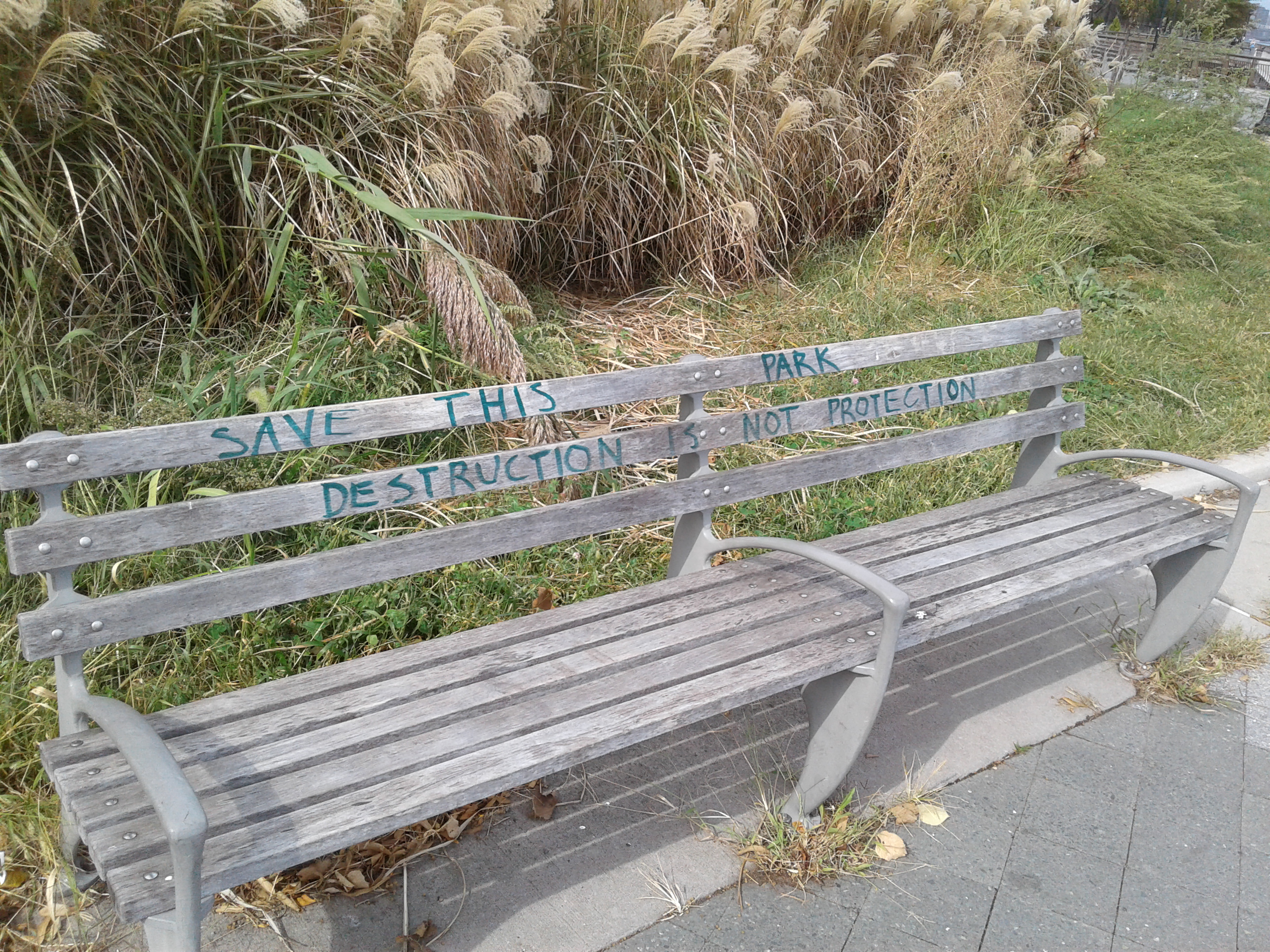
Be First to Comment